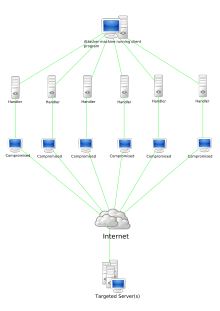An attack which attempts to block access to and use of a resource. It is a violation of availability. DDOS (or DDoS) is a variation of the DoS attack (see DOS) and can include flooding attacks, connection exhaustion, and resource demand. The distinction of DDOS from DOS is that the attack traffic may originate from numerous sources or is reflected or bounced off of numerous intermediary systems. The purpose of a DDoS attack is to significantly amplify the level of the attack beyond that which can be generated by a single attack system in order to overload larger and more protected victims. DDoS attacks are often waged using botnets. (See botnet.)
This article needs additional citations for verification. (August 2021) |
In computing, a denial-of-service attack (DoS attack) is a cyber-attack in which the perpetrator seeks to make a machine or network resource unavailable to its intended users by temporarily or indefinitely disrupting services of a host connected to a network. Denial of service is typically accomplished by flooding the targeted machine or resource with superfluous requests in an attempt to overload systems and prevent some or all legitimate requests from being fulfilled.
In a distributed denial-of-service attack (DDoS attack), the incoming traffic flooding the victim originates from many different sources. More sophisticated strategies are required to mitigate this type of attack, as simply attempting to block a single source is insufficient because there are multiple sources.
A DoS or DDoS attack is analogous to a group of people crowding the entry door of a shop, making it hard for legitimate customers to enter, thus disrupting trade and losing the business money.
Criminal perpetrators of DoS attacks often target sites or services hosted on high-profile web servers such as banks or credit card payment gateways. Revenge, blackmail and hacktivism can motivate these attacks.



